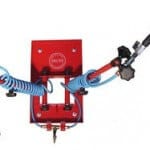Electric High Static Blower versus Compressed Air
Electric high static blowers and compressed air are popular methods of powering air movement systems in paint booths. Both styles of air movement systems provide different methods to drying paint in spray booth operations. Though, the use of electric high static blowers have many advantages over compressors related to cost and efficiency.
Electric high static blowers are a good alternative to compressors in air movement systems for several reasons:
|
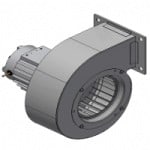 |
Electric high static blowers offer an alternative in paint booths that solve many of the problems that occur with air compressors, a major factor being cost. Electric high static blowers are a highly efficient cost alternative to operate and power air movement systems. With electric high static blower air movement systems shops are looking at a cost anywhere from $7,000 to $20,000, depending on manufacturer.
Electric high static blowers range in various air movement velocities; although a low velocity is ideal. High velocity air movement stirs overspray debris in the paint booth and contaminates the paint job. Higher velocities also cause the boundary layer to expand on the surface of the car, extending dry times. Applying lower velocities improves drying times if applied correctly and can reduce contamination during the drying process.
Filter replacement is the only maintenance required by electric high static blowers. Electric high static blowers have the ability to pull the heated air through a filter located inside the booth, thus preventing shops from having to purchase external heaters for air movement systems. One important factor to keep in mind when purchasing an air movement system powered by an electric high static blower is the placement of the air filter. A filter placed in the plenum (ceiling) of the booth is hard to access and results in an arduous process to change filters that requires multiple people, and may result in filters not getting changed at all.
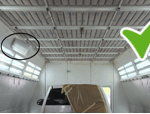 |
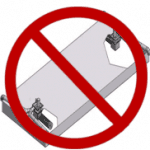 |
Airflow control gives the operator the ability to control the level of velocity an air movement system emits. Airflow control can be a tricky adjustment because pushing too much air through an air movement system increases possibility of contamination as high velocity air movement will stir more debris.
Directional control, another option on many air movement systems, allows for a painter to direct the air being pushed through the system. Some units require nozzle adjustments aimed appropriately before every use to utilize a turbulent air effect or dry specific parts of the vehicle; although some units do not require adjustments due to the utilization of dynamic air. Dynamic air movement aids in drying all parts of the car that do not receive adequate airflow, such as bumpers, without manually directing the air movement system.
 Cons on some electric high static blowers is the use of directed nozzles. Directed nozzles create a static charge that causes debris to collect on the nozzle and when the air movement system is turned on this debris contaminates the paint job. Though, some systems utilize open-cell foam that is able to capture and eliminate the dispersion of debris collected around nozzles from causing contamination, resulting in a cleaner drying process (shown below).
Cons on some electric high static blowers is the use of directed nozzles. Directed nozzles create a static charge that causes debris to collect on the nozzle and when the air movement system is turned on this debris contaminates the paint job. Though, some systems utilize open-cell foam that is able to capture and eliminate the dispersion of debris collected around nozzles from causing contamination, resulting in a cleaner drying process (shown below).
Compressor powered air movement systems have multiple negative associations with being used in paint booths.
- Expensive to purchase and operate
- High velocity air stirs debris in spray booths
- Accumulates debris
- Requires routine maintenance
- Compressed Air creates moisture, requiring drier
- Improved drying may require additional heating capability
|
Air movement systems powered by compressors have been notorious for stirring debris in paint booths causing many painters to refrain from using air movement systems or turning to handheld/venturi systems. The issue with handheld systems is the significant amount of time required by the painter to dry the wet surfaces on a vehicle. Compressed air powered movement systems are notorious for collecting debris around the nozzles, fans, etc. due to static and for contaminating the paint jobs with the collected debris. The high velocity air movement created by compressed air stirs existing debris in the paint booth, which consists of overspray, moving the protective paper on the vehicle, or causing the existing debris in the paint booth to be disturbed. |
|
|
Here is a quick way to calculate the cost:
1. Calculate Compressors running time (in hours)
2. Calculate wattage by multiplying voltage by amps
115 Volts – 1 Phase – 10 amps per horse power
230 Volts – 1 Phase – 5 amps per horse power
208 Volts – 3 Phase – 3 amps per horse power
230 Volts – 3 Phase – 2.5 amps per horse power
460 Volts – 3 Phase – 1.25 amps per horse power
574 Volts – 3 Phase – 1 amp per horse power
3. Multiply wattage by running time, then divide by 1000 to get kilowatts per hour (kWh)
4. Average rate for electricity is 12 cents per hour, multiply that by kWh, or your own electricity rate (.12 x kWh)
Example: Compressors Running Time: 4 Hours, Voltage: 460, Horsepower: 25hp
Wattage: 460 (Voltage) x 25(1.25) (Amps per horse power) = 14,375watts
Kilowatts: 4 (running time) x 14,375 (watts) = 57,500/1,000 = 57.5kWh
.12 (average rate of electricity) x 57.5 (kWh) = $6.90 for every 4 hours running
Additional air compressor expenses include routine maintenance:
- Consistent filter and oil changes, depending on type of compressor
- Checking oil levels regularly
- Checking for air or oil leaks
- Inspecting belts
- Servicing the pump or engine.
Inability to comply with maintenance requirements could result in compressor failure. Oil in the airlines has also cause problems in some cases as it can clog up the lines or air powered motors.
Moisture generated by air compressors creates another issue. Compressors require driers when being used, especially with air movement systems to ensure proper spray booth drying, adding additional cost. Moisture in the paint booth during drying can prolong the drying process thus reducing productivity. For the best productivity in compressor powered air movement systems a separate heater is required, like a heated airline, which enables the air movement system to emit heated air. If the heater is inside the paint booth and used to apply direct heat it must be listed to Class 1, Division 2 and meeting these qualifications will usually result in having to purchase a more expensive unit.
Why your shop should utilize a high static blower air movement system…
- Low Purchase Price
- Low Running Cost
- Faster Dry Times
- Easier and Cheaper to Maintain
When assessing which air movement systems will work best in a shop the units purchase price and the running cost are essential research points, especially for smaller shops. Electric high static blowers offer a cost effective alternative to air compressors in powering air movement systems and efficiently save time and money due to minimal maintenance requirements and operation costs. Electric high static blowers applied appropriately can effectively dry vehicles in less time than compressed air movement systems and results in a cleaner finish.
*This article is written by:
 Barry Thomas
Barry Thomas Keys Factors to Air Drying Paint Effectively and Efficiently



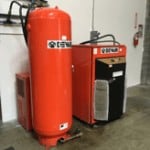
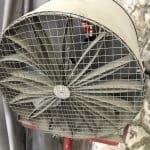 Compressor generated air movement systems such as a hand held system requires approximately 13-20 cubic feet per minute (CFM). Many times a shops air compressor cannot handle that level of output or the current air compressor might not effectively handle the strain from the additional pull, therefore a shop might require an additional air compressor. An average 10HP compressor can handle up to 35CFM and costs around $4,000 – $10,000, which could easily handle one hand held system but would struggle with two. A 20HP compressor that can handle more than three hand held air movement systems effectively is going to cost around $15,000 – $25,000 or more. This is additional cost on top of purchasing the air movement system, which varies in price according to the manufacturer. Then the cost to run the air compressor on a daily basis is significant deterrent.
Compressor generated air movement systems such as a hand held system requires approximately 13-20 cubic feet per minute (CFM). Many times a shops air compressor cannot handle that level of output or the current air compressor might not effectively handle the strain from the additional pull, therefore a shop might require an additional air compressor. An average 10HP compressor can handle up to 35CFM and costs around $4,000 – $10,000, which could easily handle one hand held system but would struggle with two. A 20HP compressor that can handle more than three hand held air movement systems effectively is going to cost around $15,000 – $25,000 or more. This is additional cost on top of purchasing the air movement system, which varies in price according to the manufacturer. Then the cost to run the air compressor on a daily basis is significant deterrent. 